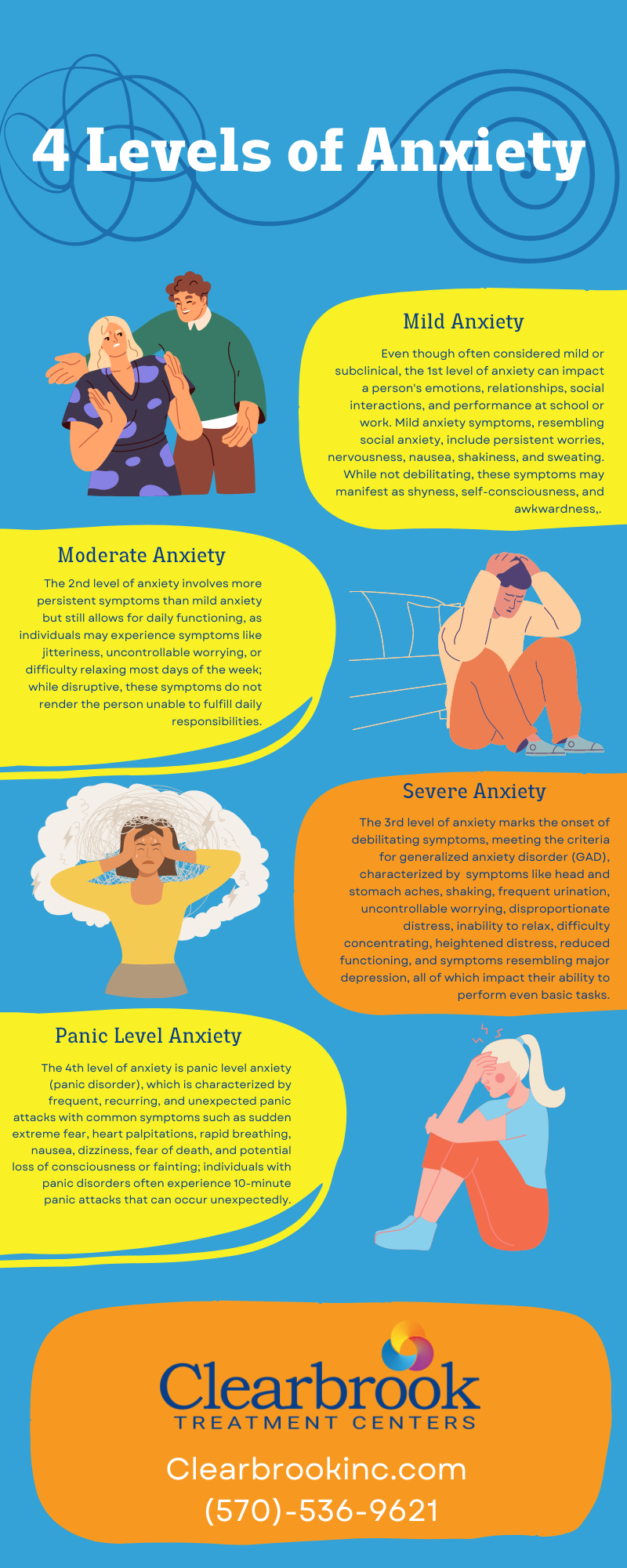It’s perfectly normal to experience anxiety from time to time. Anxiety disorders, however, are mental health disorders marked by severe and persistent anxiety, including symptoms like excessive worry and hyperarousal that disrupt day-to-day function. Anxiety is among the most common mental disorders in the United States, affecting around 19.1% of Americans each year. To better understand how impactful anxiety can be, we’re going to look into the 4 levels of anxiety and the symptoms associated with each.
What Are the Four Levels of Anxiety?
Anxiety can begin early in life or develop later on as a culmination of genetic or biological factors or life experiences. Anxiety usually has an average onset of 11 years old and can produce symptoms that range from mildly uncomfortable to severe and debilitating.
The four levels of anxiety are mild anxiety, moderate anxiety, severe anxiety, and panic level anxiety, each of which is classified by the level of distress and impairment they cause. The four components of anxiety can also be influenced by the person’s personality, coping strategies, life experiences, and gender.
 A family history of mental illness such as anxiety can also increase one’s likelihood of developing a similar condition. Below are the 4 levels of anxiety and the symptoms they produce.
A family history of mental illness such as anxiety can also increase one’s likelihood of developing a similar condition. Below are the 4 levels of anxiety and the symptoms they produce.
Mild Anxiety
Although it’s usually seen as mild or subclinical, mild anxiety can impact a person’s emotions, relationships, ability to socialize, and performance at school or work. Mild anxiety symptoms are similar to those of social anxiety, including constant worries that are ignored, nervousness, nausea, shakiness, and sweating. Although most of these symptoms occur in most people with anxiety disorders, in people with mild anxiety, they aren’t debilitating.
A person with mild anxiety may come across as being shy, self-conscious, and even a little awkward. These symptoms are usually present since childhood and can progress into adulthood if left unaddressed. In addition to worsening symptoms, the development of unhealthy coping strategies – such as alcohol abuse – is a serious concern for people who do not receive counseling or therapy for mild anxiety.
Moderate Anxiety
Moderate anxiety is anxiety level 2, which involves more frequent or persistent symptoms than those of mild anxiety, but still allows for daily functioning in comparison to severe anxiety or panic disorder. For instance, people with moderate anxiety may experience symptoms like jitteriness or feeling on edge, being unable to control their worrying, or being unable to relax for most days of the week.
Although moderate anxiety symptoms are disruptive, they aren’t debilitating enough to disrupt the person’s day-to-day routine or prevent them from fulfilling responsibilities at work, home, or school. Again, however, it’s important to note that even moderate anxiety should be treated, as individuals with anxiety disorders are likely to develop harmful coping habits that could worsen their symptoms in the long run.
Severe Anxiety
The third level of anxiety is where debilitating symptoms begin to emerge. Severe anxiety symptoms meet the diagnostic criteria for clinically-significant anxiety disorder or generalized anxiety disorder (GAD). There are physical symptoms of severe anxiety, including head and stomach aches, shaking, and frequent urination, and then there are behavioral symptoms, like the inability to control worrying, distress that’s disproportionate to the situation, inability to relax, difficulty concentrating, and more.
People with severe anxiety usually experience more distress and less ability to function. A person with this condition may also report symptoms similar to those of major depression, such as fatigue, headaches, and impaired concentration and memory. Severe anxiety symptoms are persistent and frequent, making it more difficult for the person to function and complete even the most basic tasks.
Panic Level Anxiety
The fourth level of anxiety is panic level anxiety, or panic disorder, which is characterized by frequent, recurring, and unexpected panic attacks. Common panic attack symptoms include:
- Sudden onset of extreme fear and sense of doom
- Heart palpitations or rapid heartbeat
- Rapid breathing
- Nausea or dizziness
- Fear of death
- Loss of consciousness or fainting
In people with panic disorders, panic attacks usually last around 10 minutes and can occur unexpectedly. Panic attack triggers vary from person to person, so it’s helpful to work with a therapist or mental health specialists to determine what these triggers are and develop appropriate coping mechanisms.
Help for Anxiety
No matter which of the four components of anxiety you’re struggling with, our Massachusetts treatment center can help. Clearbrook Treatment Center offers residential mental health care that provides individual and group therapy options for people with anxiety disorders, panic disorder, depression, OCD, and more. We even offer various levels of addiction care to help people who suffer from substance use disorders, as well.







